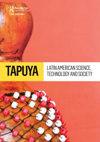Towards a Terrestrial Internet: re-imagining digital networks from the ground up
IF 1.2
Q2 HISTORY & PHILOSOPHY OF SCIENCE
Tapuya: Latin American Science, Technology and Society
Pub Date : 2022-11-12
DOI:10.1080/25729861.2022.2139913
引用次数: 1
Abstract
The expansion of digital infrastructure is having material and concrete impacts on society and the environment. This phenomenon is rendering obsolete binary distinctions between the “physical” and the “virtual” worlds. Giving a step further in this discussion, the articles comprising this Cluster trace the emergence of an imaginary that approaches territory as an actor actively shaping the development and governance of the internet. What we call the Terrestrial Internet is emerging from Indigenous, Afrodescendant, feminist and worker groups in Abya Yala (Latin America) envisioning alternative imaginaries as digital infrastructures expand in their contexts. In dialogue with science and technology studies (STS) and Latin American critical thought, we argue that this imaginary conceives of the internet as an earthly development whose material expansion is spurring novel human and non-human alliances and frictions, as well as colonial forms of territorial occupation. The articles that make up the Cluster were invited to respond key questions in times of terricide: What are the power dynamics of the disputed spaces that support the internet? What are the effects of such dynamics on territories and their various ways of life in Abya Yala? What imaginaries are put in motion as a response? The emergence of the internet was accompanied by claims on its alleged “cyber” or “virtual” character, as if it would be a realm different from the “physical” world. However, phenomena such as the increasing extraction of lithium to build so-called “green” technologies (Peña 2020) and disputes over the vast volumes of water required to cool off data centers (Hogan 2015; Hu 2015) are rendering such deterritorialized imaginaries obsolete. The concrete and material character of the aforementioned phenomena were overlooked in initial accounts of the impact of the internet, but are becoming now increasingly relevant for understanding the range of inequalities and politics associated with the development and expansion of the so-called network of networks. Looking at the materialization of these trends in Abya Yala, this Cluster develops the Terrestrial Internet imaginary by drawing on a series of articles chronicling varied走向地面互联网:从头开始重新构想数字网络
数字基础设施的扩展正在对社会和环境产生实质性和具体的影响。这种现象正在使“物理”和“虚拟”世界之间的二元区分变得过时。在这个讨论中更进一步,组成这个集群的文章追溯了一种想象的出现,这种想象将领土视为积极塑造互联网发展和治理的行动者。我们所说的地面互联网是由拉丁美洲阿比亚亚拉(Abya Yala)的原住民、非洲裔、女权主义者和工人团体提出的,他们设想了数字基础设施在他们的环境中扩展的另一种想象。在与科学技术研究(STS)和拉丁美洲批判思想的对话中,我们认为,这种想象将互联网视为一种世俗的发展,其物质扩张正在刺激新的人类和非人类联盟和摩擦,以及领土占领的殖民形式。该丛书的文章受邀回答大屠杀时期的关键问题:支持互联网的争议空间的权力动态是什么?这种动态对阿比亚亚拉地区的领土及其各种生活方式有什么影响?什么样的想象被付诸行动作为回应?互联网的出现伴随着对其所谓的“网络”或“虚拟”特性的主张,仿佛它将是一个不同于“物理”世界的领域。然而,诸如不断增加的锂提取以建立所谓的“绿色”技术(Peña 2020)以及冷却数据中心所需的大量水的争议等现象(Hogan 2015;Hu 2015)正在使这种去地域化的想象过时。上述现象的具体和物质特征在最初对互联网影响的描述中被忽视了,但现在对理解与所谓的网络的网络的发展和扩张相关的不平等和政治的范围变得越来越重要。着眼于这些趋势在Abya Yala的实现,本丛书通过一系列记录各种趋势的文章,发展了地面互联网的想象
本文章由计算机程序翻译,如有差异,请以英文原文为准。
求助全文
约1分钟内获得全文
求助全文
来源期刊

Tapuya: Latin American Science, Technology and Society
Social Sciences-Social Sciences (all)
CiteScore
1.60
自引率
0.00%
发文量
39
审稿时长
19 weeks
 求助内容:
求助内容: 应助结果提醒方式:
应助结果提醒方式:


